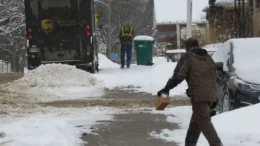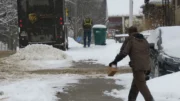The following suggestions will help you to successfully plant fruit trees.
Time of planting: Dormant fruit trees can be planted in the spring as soon as the ground can be worked without fear of damaging the soil structure. In most parts of Pennsylvania this can occur anytime from March through mid-May. The later the trees are planted, however, the slower they will begin to grow.
Handling the trees: As soon as the plants arrive, open the package. Report any signs of damage or poor handling to the nursery immediately.
Holding the trees until planted: Trees to be held for several days should be heeled-in, or placed in cold storage with the roots covered with moist soil, sawdust, or sand. Never permit the roots to become dry.
On the day before planting, place the trees in water so that all of the roots are covered. Allow the trees to absorb water for up to 4 hours.
The hole in which each tree is to be planted should be wide enough to accommodate all of the tree’s root system without excessive bending or bunching of the roots. It should be deep enough so that the bud union will be no more than 2 to 3 inches above the ground after the soil settles. Grafted or budded trees should always be planted so their union is above the soil line.
Clonal rootstock trees: Observe which side of the root system has the most roots. Set the tree so that the side of the root system with the most roots is pointed into the direction from which the prevailing winds come. This will afford added anchorage.
Planting the tree: Add 4 to 6 inches of soil to the hole, while at the same time gently jiggling the tree up and down. This will cut down on the possibility of air pockets and help the soil to surround all of the roots.
Fill the hole to within 3 to 4 inches of the ground line. Tramp the soil firmly, then add the remaining soil up to the ground line.
Apply 5 gallons of water to each tree after planting. It is important to use at least 5 gallons to ensure complete wetting of all soil and roots in the hole.
In the absence of a soil test, a reliable rule of thumb is to use the equivalent of 1/2 pound of 10-10-10 fertilizer per tree except for pears, in which case 1/4 pound per tree will be adequate. Sprinkle the fertilizer in a 12-inch-wide band. Keep the fertilizer at least 6 inches away from the tree trunk. Do not apply any dry granular fertilizer near the tree until after the ground has settled and no cracks in the soil are evident.
After the water has moved into the soil, add a tree guard. A 15-by-18-inch piece of 3/8-inch hardware cloth (formed into a circle using the 18-inch dimension as the circumference) makes an excellent guard. Bury the bottom of the guard 1 to 2 inches into the soil or into finely crushed stone, which helps to reduce weeds and rodent damage when it is spread around the base of the tree.
When planting bare-root trees, remember that approximately one-quarter of the root system was removed when the tree was dug. To compensate, remove about one-quarter of the top part of the plant to reestablish a 1:1 shoot-to-root ratio.
Trees that come balled and burlapped do not need as much pruning; remove only broken or low-hanging branches.
Watering the young tree in late June may be desirable depending on the rainfall up to that time.
If less than 4 to 5 inches of rain have fallen since the trees were planted, apply 5 gallons around the base of each tree. You might have to hoe a small ridge of soil around each tree to prevent the water from running off.
This educational blog is a series of informative articles from the Penn State Master Gardeners volunteers plus news concerning the group and their activities. For more information, click here.



































